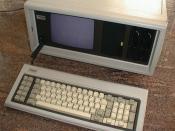Introduction
In 1984, after generating $80,000 revenue per month from upgrading and selling computers out of his dorm room, Michael Dell dropped out of the University of Texas and founded Dell Computer Corporation. The upstart company was pitted against established industry giants such as IBM, Compaq, and Hewlett Packard; but by use of ingenious strategy and revolutionary business models Dell thrived and grew every year. Now they are on top of the US PC market and competitors are scrambling to catch up.
Rather than rest and enjoy their incredible success, Dell now attempts to assess their current situation and take a look to the future. Will competitors try to imitate their strategies? If so, can they be successful? And if Dell's production and distribution models are successfully imitated, what will be their source of competitive advantage? As Dell ponders these disturbing questions, they consider changing the strategy that has done so well for them.
Existing Strategy
In order to recommend a course of action that may involve changing Dell's strategy, we first must understand Dell's current strategy. Dell pioneered the Direct Model in the PC industry. This means that while their competitors sold computers to distributors, resellers, and retail stores; Dell sold directly to the customer. This is also known as dis-intermediation or removing the middleman in a transaction. The first, and most notable, benefit of this is that Dell realizes higher gross margins than their competitors. For instance, Compaq and Dell make a similar computer that has the same processor, operating system, and equivalent accessories/features. This computer sells for $1499. Consumers can either buy the computer from a local reseller or order it directly from Dell. Also, both companies spent $1215 to make the computers. Now the difference is in the distribution model. Compaq sells the computer...


